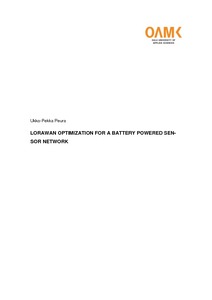LoRaWAN optimization for a battery powered sensor network
Peura, Ukko-Pekka (2018)
Peura, Ukko-Pekka
Oulun ammattikorkeakoulu
2018
All rights reserved
Julkaisun pysyvä osoite on
https://urn.fi/URN:NBN:fi:amk-201805168526
https://urn.fi/URN:NBN:fi:amk-201805168526
Tiivistelmä
The aim of this bachelor’s thesis was to study LoRaWAN limitations and power consumption in real life working conditions for Etteplan Oy. Etteplan Oy was interested in using LoRaWAN in its future Internet of Things (IoT) projects and thus needed to know more about its suitability on various use cases, with a strong emphasis on battery powered devices. This thesis aims to provide guidelines for designing and developing LoRaWAN based embedded devices and networks. The thesis will also outline edge cases and problems that might otherwise go unnoticed when developing such a device.
A full protocol specification and regional parameters for LoRaWAN were available from The LoRa Alliance. These documents were used to study how LoRaWAN works and how some of its features are implemented. The documentation also contains some recommendations for using this technology. For things that were not explained in the specification, a test on the actual hardware and software was performed to test how the protocol works. Real world testing for range was also performed on suburban and open areas. The software used on end devices was built with Mbed OS 5.8 with an integrated LoRaWAN stack.
The result of the study was that LoRaWAN’s suitability must be carefully investigated on case basis. The device designer must know several design parameters before considering how well LoRaWAN would fit into this design. Such design parameters include: the wanted battery life, required wireless transmission range, payload size and message frequency. LoRaWAN has clear advantages when transmitting very small amounts of data infrequently, and a when good object penetration is required. On the other hand, LoRaWAN is not suitable for designs where a high bandwidth or a fast packet rate are required. Power consumption is also very dependent on the use case but power consumption can also be easily predicted if that is required by the design.
A full protocol specification and regional parameters for LoRaWAN were available from The LoRa Alliance. These documents were used to study how LoRaWAN works and how some of its features are implemented. The documentation also contains some recommendations for using this technology. For things that were not explained in the specification, a test on the actual hardware and software was performed to test how the protocol works. Real world testing for range was also performed on suburban and open areas. The software used on end devices was built with Mbed OS 5.8 with an integrated LoRaWAN stack.
The result of the study was that LoRaWAN’s suitability must be carefully investigated on case basis. The device designer must know several design parameters before considering how well LoRaWAN would fit into this design. Such design parameters include: the wanted battery life, required wireless transmission range, payload size and message frequency. LoRaWAN has clear advantages when transmitting very small amounts of data infrequently, and a when good object penetration is required. On the other hand, LoRaWAN is not suitable for designs where a high bandwidth or a fast packet rate are required. Power consumption is also very dependent on the use case but power consumption can also be easily predicted if that is required by the design.
